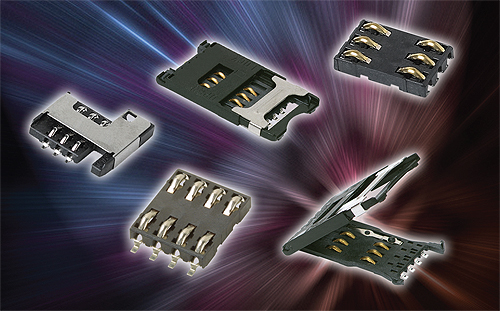As design methods evolve, the fasteners and joining tools available to you change too. Here’s a look at some of the newer offerings.
The methods and products available to attach two pieces of a design together are multiple and varied to meet nearly every conceivable need. However, new needs constantly arise. Today’s design needs include fastening and joining methods that can handle vibration, thinner boards, smaller products, and higher temperatures. These needs spur the fastening and joining industry to innovate, so here’s a look at some of the latest fastening and joining products.
Clamp together
Clamping is a fundamental form of fastening or joining parts together. One example of the newer designs is the Series GN 418 Cam Point Screws and GN 418.1 Cam Point Levers from J.W. Winco. These screws and levels are maintenance-free clamping elements for such applications as clamping flat or round work pieces, centric clamping in bore holes, and multiple clamping in tight spaces.

The Series GN 418 Cam Point Screws and GN 418.1 Cam Point Levers from J.W. Winco, will clamp flat or round work pieces, handle centric clamping in bore holes, and multiple clamping needs in tight spaces.
The mode of function is identical for both: The screw head of the cam point screw is fitted with two cams: a radial clamping cam (with additional 30° chamfer) and an axial draw-down cam. The self-locking cam ensures that the clamping force is of the same magnitude in every angular position. The force components acting at the clamping point generate friction and a draw-down effect presses the workpiece against a fixed-end stop. The thread and the 30° chamfer (if fitted) generate an additional draw-down effect.
Cam point screws are fitted with a hexagon head socket. The steel is case-hardened, zinc-plated and blue passivated. Cam point levers have a handle (with black plastic ball knob) connected to the cam point screw with a serration, allowing the suitable clamping position to be selected and the lever to be adjusted. Both the screw and the cam are case hardened and burnished.
A hinge, for movable joining
When two parts must join but include some ability to move or rotate, a coiled spring pin can be a suitable option. One type of coiled spring pin, made by Spirol, is rolled with 2-1/4 coils of rolled material, which results in a seam that all coiled pins possess. The difference with this particular pin is that the seam is not raised above the pin surface. Instead it is ‘tucked’ or rolled to ensure the pin remains round. In addition, the seam is prepared with a beveled edge to soften the transition into the ‘comma’ area. According to Spirol, a properly rolled coiled pin has a diameter at the seam that is equal to or less than the diameter adjacent to the seam. This prevents the edge of the material from contacting the inside diameter of the hole wall and skiving when inserted.

This SUV rear window latch assembly uses three Coiled Pins as hinges.
One application of these pins is in the plastic rear window latch assembly of an SUV car. The pin conforms to the hole in which it is installed and the ‘comma’ area is visible as a small gap between pin and hole adjacent to the seam. The tucked seam allows smooth, interference-free rotation of hinge/axle components.

Coiled Pins are often used as hinge pins in durable consumer products as demonstrated in this toilet float arm assembly.
In most situations where the seam is problematic, it is typically the result of poor installation methods or improper implementation. If excessive compressive force is applied to one part of the pin and not another, the seam may deform. Seam deformation can happen when assemblies do not properly support the pin. Similarly, pins can be damaged during installation and this can lead to deformation at the seam. Improper installation technique, equipment, hole condition, or pin material and duty are typical causes.

Slotted Spring Pins have a “C” shape. Coiled Spring Pins have 2 1/4 coils of rolled material.
Coiled and slotted pins can be used in assemblies where a ‘pawl’ or lever must ride on the surface of the pin as it rotates. However, pay attention to the geometry of the lever, which can sometimes catch or ‘hang up’ on the seam.

The Coiled Pin’s seam is prepared with a beveled edge to soften the transition into the ‘comma’ area. This design feature ensures that there are no “high spots” at the seam.
An easy way to attach thin parts
As the design trend of creating thinner boards continues, fastening manufacturers have introduced fasteners that can attach thin boards without damage. For example PEM® fasteners from PennEngineering have a float capability that eases the alignment of mating threads during attachment. This capability also gives you tolerance flexibility. The family of floating fasteners includes captive panel screws and self-clinching nuts.

Floating fasteners, such as these PEM® fasteners from PennEngineering, ease the alignment of mating threads during attachment. This capability also gives you tolerance flexibility.
Floating captive panel screws install into metal or non-metal panels as thick as 0.63 in. (1.6 mm). They enable access to an assembly and compensate for up to 0.060 in. (1.52 mm) mating hole misalignment. MAThread® anti-cross threading technology corrects off-angle installations, aligns components, and slides through clogged internal threads. A shoulder on the retainer portion of the fastener helps simplify installation. Thread sizes range from #4-40 through ¼-20 and M3 through M6.
Floating self-clinching nuts can be specified with non-locking threads or self-locking threads. They provide permanent load-bearing threads in metal sheets as thin as 0.038 in. (0.97 mm) and permit a minimum of 0.030 in. (0.76 mm) adjustment for mating hole misalignment. Their design allows the fastener’s threads to extend fully into the retainer shank to impart added strength and support in an assembly. Thread sizes range from #4-40 through 1/4-28 and M3 through M6. Types A4 and LA4 fasteners specifically are designed for use in stainless steel sheets.
Simple, semi-permanent, yet fast
For semi-permanent fastening applications, the quick locking pin, named the SLIC Pin™, functions as a pin and cotter all in one. SLIC is an acronym for Self Locking Implanted Cotter, and as the name implies, the pin is secure and self-locking through the use of an implanted plunger (locking detent) that functions as a self-contained cotter pin.

The SLIC Pin™, from Pivot Point Inc., can replace labor-intensive fastening combinations such as a clevis pin & cotter pin, a pin and retaining ring or a nut and bolt. The simple, one-piece design means faster assembly speeds.
Made by Pivot Point Inc., the spring loaded “wedge shaped plunger” easily and automatically retracts when the pin is inserted into a hole. The angled, ramp-like face of the wedge ensures smooth insertion. Once fully inserted, the plunger springs back up, locking the pin into the application. The vertical face at the rear of the plunger prevents the pin from backing out.
The pin can replace other labor-intensive fastening combinations such as a clevis pin and cotter pin, a pin and retaining ring or a nut and bolt. The simple, one-piece design means faster assembly speeds. It is inserted from just one side. There is no need to access the other side to secure another fastener such as a cotter pin, a nut or a clip.
Beyond 100,000 load cycles
Medical implants and their components—including the fasteners that hold them together—must be built to last longer than ever before. To handle the demands of longer-lived, active patients, some medical device companies are going beyond what’s currently required. For instance, some are specifying self locking fasteners in implants of the upper extremities that go way beyond 100,000 load cycles to withstand up to one-million load cycles without loosening or backing out.
Skeletal Dynamics, a Miami-based designer of orthopedic devices, developed the Align™ Radial Head System, an artificial elbow joint designed to restore the natural function of the native radial head. This design eliminates the drawbacks of misalignment and inability to lock into proper position of earlier approaches to prosthetic radial head design.
Said Tom Norman, Vice President of Engineering at Skeletal Dynamics, “We considered traditional fastener thread forms, but lacked confidence that they would stay in place for the up to a million load cycles an active patient could subject them to in their lifetime. Instead, we selected an innovative self locking fastener called Spiralock.”
Because repetitive loads, shock and loosening must be decisively handled for implant use, traditional fasteners are not always appropriate. Testing, in fact, has found that the first two threads of traditional fasteners can carry as much as 80% of the load, permitting stripping or shearing, while subsequent male threads “float” within the female threads. The Spiralock self-locking fastener resists loosening even under loads and vibrations strong enough to break it.

The Spiralock self-locking fastener resists loosening even under loads and vibrations strong enough to break it thanks to a 30º wedge-ramp cut at the root of the female thread.
This fastener uses a 30º wedge-ramp cut at the root of the female thread. Traditional fasteners use a 60º thread. Under clamp load, the crests of the threads on any standard male bolt are drawn tightly against the wedge ramp. This action not only eliminates sideways motion that causes vibrational loosening but also distributes the threaded joint’s load throughout all engaged threads, a claim supported by a Massachusetts Institute of Technology research study. The load percentage on the first engaged thread is significantly lower than traditional thread forms, which further reduces possible bolt failure and improves product performance.
When Skeletal Dynamics’ Align™ Radial Head System is surgically installed in a patient, proprietary instrumentation allows alignment of the radial head as it would be in the patient’s native anatomy. Once the surgeon orients the device in this natural position, the surgeon tightens the set screw in a Spiralock milled interrupted thread made of cobalt chrome, against a long titanium stem designed for 3-point fixation, to lock the device in the correct position.
“While fasteners used in upper extremities are frequently tested to 100,000 cycles, third-party testing showed that the Spiralock self locking fastener used on the Align™ Radial Head successfully survived load and fatigue testing to one-million cycles without loosening or backing out,” said Norman. “That gave us the design confidence we needed, and helped with our FDA approval.”
Density and ruggedness
Machine-to-machine devices are often subjected to harsh environmental conditions, including high temperatures, vibration, dust, moisture and other contaminants. The CCM03 and CCM04 Series smart card connectors, from C&K Components, provide the ruggedness and reliability required for such applications while offering high-density contact.

The CCM03 and CCM04 Series smart card connectors, from C&K Components, are rugged and reliable for machine-to-machine connections. And they offer high density contact and built-in card detection switch.
This rugged smart card connector includes a built-in card detection switch for machine-to-machine applications. These harsh environment connectors meet IEC 512 certification and are resistant to shock, vibration, humidity and extreme temperatures. The connectors handle asset tracking, automotive e-call and tracking, signage, metering, vending machine, security and remote monitoring applications.
Depending on the type, the CCM03 Series features an insulated normally open (NO) card detection switch or increased contact forces for maximum vibration resistance. Both series are available with standard gold plated contacts or with specific inlay alloy for increase wear and corrosion resistance. The smart card connectors have a contact system that features 6 or 8 contacts and a mechanical life of 10,000 to 50,000 cycles, depending on the type.
The CCM03 provides a maximum card insertion force of 3 N for fixed cover and 1 N for hinged cover with a contact force ranging from 0.25 N to 0.50 N. The CCM04 Series has a 10 N maximum insertion force and a contact force ranging from 0.4 N to 0.7N.
Easier delivery of adhesives
When a mechanical option won’t due, adhesives can be an excellent choice. One trend in this area is the development of new delivery methods for adhesives, methods that reduce manual work as well as improve accurate placement of the adhesive material.
For example to improve quality and reduce waste associated with manufacturing processes that rely on hand-dispensed instant adhesives, Henkel Corporation has developed the Loctite® CA Volumetric Hand Pump. This hand-held dispenser ensures precise and repeated dispensing of Loctite® brand instant adhesives (cyanoacrylates).

The Loctite® CA Volumetric Hand Pump is a hand-held dispenser that ensures precise and repeated dispensing of Loctite® brand instant adhesives (cyanoacrylates).
The hand pump does not use pneumatics, battery or electric power. Instead it has six pre-set shot sizes and an adjustable range of 0.009 to 0.002 grams of adhesive. This volumetric dispenser ensures that the adhesive never over- or under-doses for an application, resulting in minimal adhesive waste. The sealed hand pump connection to the bottle stops air and moisture from entering the system, preventing the instant adhesive from solidifying and increasing its working life.
The hand pump dispenses from either 20-gram or 1-ounce bottles of Loctite® instant adhesives. The pump has an easy-pull trigger and is lightweight. Its ergonomic design minimizes hand fatigue experienced during priming and dispensing. The unit measures 7.5 x 7.75 x 2.5 in. and weighs 282 grams.
Discuss this on The Engineering Exchange:

C&K Components
www.ck-components.com
Henkel Corporation
www.henkelna.com/industrial
J.W. Winco
www.jwwinco.com
PennEngineering
www.pemnet.com
Pivot Point Incorporated
www.pivotpins.com
Spiralock
www.spiralock.com
SPIROL International Corporation
www.spirol.com





Tell Us What You Think!